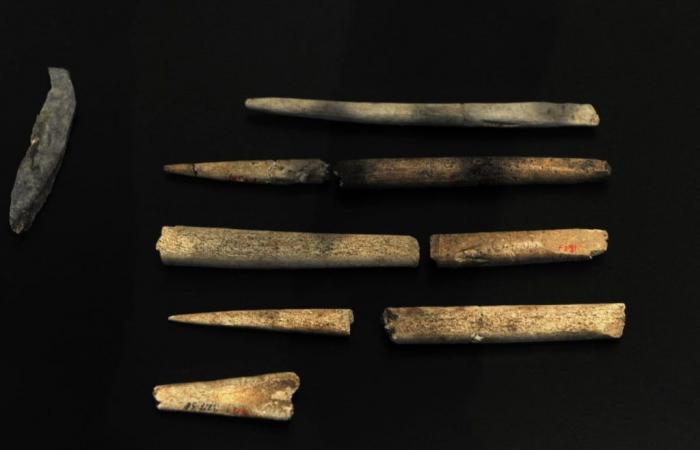
If you look around you, you are surrounded by technology that you probably don’t know how it works, and if you do, you wouldn’t be able to reproduce. And we’re not just talking about the complex chips of the mobile phone. The ink that impregnates the pages of a book, the synthetic fabric of a T-shirt or a metal key requires an enormous and combined amount of knowledge, which is distributed among many people and appeared through the accumulation of knowledge over countless generations. This ability to acquire knowledge from ancestors and pass it on to descendants after adding some improvement, and to do so with precision, beyond the bulk copying of what others do, which has been seen in chimpanzees and monkeys, is one of the abilities that still seem exclusive to humanity.
Therefore, looking for the origin of this capacity to accumulate culture is also looking for something similar to human origin. An article that was published this Monday in the magazine PNAS and signed by Jonathan Paige, from the University of Missouri, and Charles Perreault, from Arizona State, both in the United States, tries to identify that crucial moment, which they place around 600,000 years ago. They arrived at that figure after analyzing stone tools from the last 3.3 million years, comparing the complexity of tools produced by other animals and doing experiments in which researchers made lithic tools to put themselves in the shoes of those prehistoric humans. .
There are indications that more than three million years ago, in places like Dikika, in Ethiopia, or Lomekwi, in Kenya, the first hominids used stone artifacts to extract meat from animals. These early tools made possible a better diet that allowed for growth of the body and brain and greater manual skill to create better gadgets. At first, cores and flakes were generated without much planning, pursuing an intuitive utility like that sought by some monkeys today when producing flakes, not unlike those used by the first members of the genus Homo. This way of doing things was transmitted for hundreds of thousands of years, at a rate that was still far from that associated with the human species.
The change was gradual, with technologies that could be learned with some ease and little information, simply by watching how others did it. The authors even propose that 1.8 million years ago, after the appearance of hand axes, which represented an important technological leap and greater planning, a certain stagnation occurred, because manual skill was not enough to continue with the same rapid advance. That changed 600,000 years ago. The transformations that are beginning to be seen in the tools of that time, finer and more diverse, require dedicating a lot of time to learning and it is possible that stone carving was transmitted in the same way that a trade is taught now.
The authors argue that the rapid and continuous increase in complexity can be explained by the ability of those hominids to accumulate culture. A greater variety of tools, carving forms and combinations of elements appear that exponentially multiply the possibilities of technology. As new carving techniques are discovered, design possibilities expand. For example, soft hammer percussion and pressure carving allow thinner hand axes to be made than is possible with hard hammer percussion. These more complex technologies are also more difficult to discover, master, and teach.
The evolution of the cultural heritage occurs at the same time as the biological changes that facilitate learning from a very early stage of life. Cooking, for example, reduced the size of the intestine and made it easier to extract more energy to fuel the brain from the same amount of food. This favors the growth of a brain with the capacity to acquire increasingly complex skills or to handle the fingers with a finesse essential to create more subtle devices.
Although the great technological explosion is usually associated with the appearance of modern humans, Paige and Perreault propose that cumulative culture may predate the separation of the Neanderthal and Sapien lineages, and that a common ancestor could have developed it. “This is reflected in the overlapping complexity of both groups during the Late Pleistocene,” they say, and could explain why some researchers have seen that the technologies associated with Neanderthals in the Middle Pleistocene are more complex than some related to modern humans at the time. end of that period.
Ignacio de la Torre, CSIC researcher, doubts that there is convincing evidence that Neanderthals are capable of developing more advanced gadgets than sapiens, but suggests that “the technological or innovation explosion could be attributed to a kind of precursors of Homo sapiens”. Although the relationship between archaeological remains and the biological characteristics of the beings that created them is not always clear, and many technologies are so useful that they are transmitted between species for long periods, De la Torre does not rule out that the innovative fever ends up being associated with the presence of a human species with more modern characteristics that has not yet been identified.
“Every four or five years new discoveries of Homo sapiens older,” he says. “Until about 15 years ago, the oldest remains were 100,000 years old. Later, remains from 150,000 years ago appeared, 50% older, and in 2017 remains of modern humans from 300,000 years ago were published. The chronology of Homo sapiens in just over 15 years,” says De la Torre. “These equivalences between biology and archeology must be taken with a grain of salt, but who tells us that in a few years time no remains of Homo sapiens from half a million years ago?” he concludes.
You can follow SUBJECT in Facebook, x and instagramor sign up here to receive our weekly newsletter.





